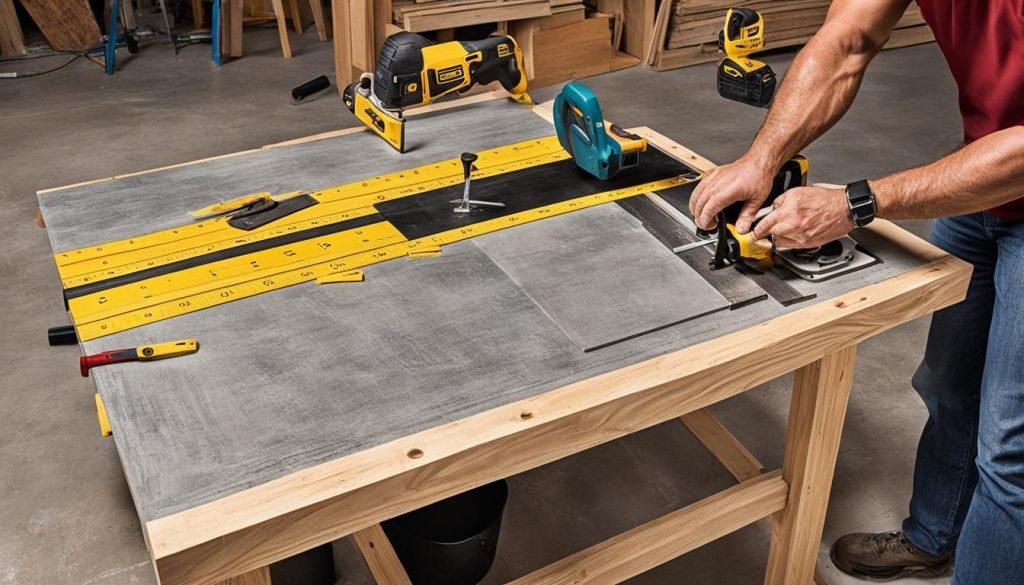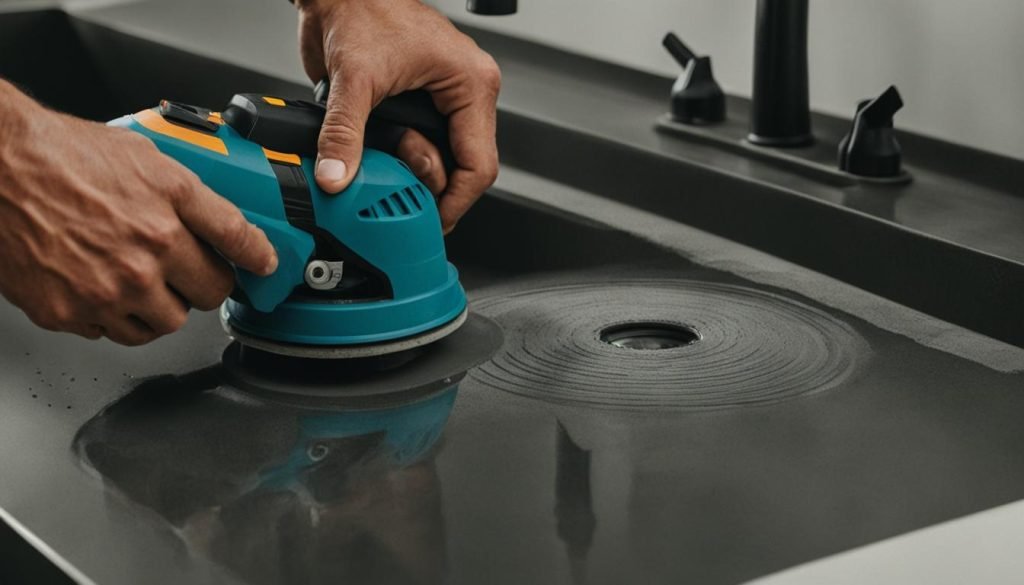Making a concrete sink can be a cost-effective and unique addition to your home. By following these steps and tips, you can create a custom concrete sink that adds style and functionality to your space.
To make a concrete sink, you will need materials such as a sink mold, rebar or wire mesh, concrete mixture, and tools like a concrete vibrator and sandpaper. The process involves building the lower and upper forms, pouring the concrete, and refining the sink to achieve a smooth and polished finish. If you need more information, check out our Townsville Concrete Services. In addition, if you’re thinking about upgrading your space with bamboo flooring, explore our guide on ‘How to Lay Bamboo Flooring on Concrete Slab: A Step-by-Step Guide’ for seamless installation tips and expert advice that perfectly complements your polished concrete surface.
Key Takeaways:
- Creating a concrete sink is a cost-effective way to add style and functionality to your home.
- Key materials for making a concrete sink include a sink mold, rebar or wire mesh, and a concrete mixture like Quikrete 5000.
- The process involves building the lower and upper forms, pouring the concrete, and refining the sink to achieve a smooth finish.
- Refinements such as sanding, applying a slurry coat, and sealing the concrete can enhance the appearance and durability of the sink.
- Take your time during each step of the process to ensure a high-quality end result.
Step 1: Materials and Tools
Making a concrete sink requires the use of specific materials and tools to ensure a successful DIY project. Here are the essential items you will need:
Materials:
- Sink mold
- Rough rock edge liner (optional)
- Silicone
- Mold release wax
- Rubber sink knockouts
- Denatured alcohol
- Rebar or wire mesh
- Crete-lease release agent spray
- Concrete mixture (such as Quikrete 5000)
Tools:
- Concrete vibrator
- Sander or sawzall for vibrating the form
- Fine-grit sandpaper for refinishing
- Turbo cup wheel for grinding
- Angle grinder for cleaning up the dried concrete
Having the right materials and tools will help you achieve professional-looking results when constructing your concrete sink. Make sure to gather all the necessary items before starting the project. Now that you have your materials and tools ready, let’s move on to the next step: building the lower form.
Step 2: Building the Lower Form
In order to create a concrete sink, the first step is building the lower form. This crucial step provides the foundation for the entire sink construction process. Here are some concrete sink construction tips to help you with building the lower form:
Create a Stable Base
To start, use melamine sheets and silicone to construct both the base and side walls of the lower form. Melamine sheets are ideal for their smooth and durable surface, which prevents the concrete from sticking. Silicone is used to seal the edges and corners of the form, ensuring a tight and secure fit.
Attach the Sink Mold
Next, attach the sink mold to the center of the lower form. The sink mold will determine the shape and size of your concrete sink, so ensure that it is positioned accurately. Use strong adhesive or clamps to secure the mold firmly in place within the form.
Install Rubber Sink Knockouts
Place rubber sink knockouts in the areas where the fixtures, such as faucets and drains, will be located. These knockouts act as placeholders, ensuring that the necessary holes are left open during the concrete pouring process. Pay close attention to their positioning to ensure proper alignment and functionality.
Ensure Proper Sealing and Leveling
Before proceeding, ensure that all edges and corners of the lower form are properly sealed with silicone. This prevents any concrete mixture from leaking out during pouring. Additionally, use a level to ensure that the form is perfectly horizontal. This will help achieve an even distribution of the concrete mixture and ensure a uniform shape for the sink.
Add Reinforcement for Strength
To provide added strength and durability to your concrete sink, consider reinforcing the lower form with materials such as rebar or wire mesh. These reinforcements help prevent cracking and ensure long-term stability. Place them strategically within the form, focusing on areas that may experience more stress or weight.
By following these tips and building a sturdy lower form, you are laying the foundation for a successful concrete sink construction project. Next, we will move on to step 3: Building the Upper Form.
| Building the Lower Form Tips: |
|---|
| Create a stable base using melamine sheets and silicone |
| Attach the sink mold securely to the center of the form |
| Position rubber sink knockouts for fixtures |
| Seal edges and corners properly with silicone |
| Ensure the form is level for even concrete distribution |
| Add reinforcement like rebar or wire mesh for strength |
Step 3: Building the Upper Form

Building the upper form is a crucial step in the step-by-step concrete sink process. The upper form is designed to be slightly larger than the sink mold and is sloped to follow the shape of the sink. This ensures that the concrete will flow smoothly and evenly into the mold, creating a seamless finish.
Before building the upper form, it’s essential to clean the entire form with denatured alcohol. This step removes any excess silicone and debris, ensuring a clean surface for the concrete. Additionally, a thorough coat of release agent spray should be applied to prevent the concrete from sticking to the form.
Reinforcement is another important consideration during the upper form construction. Adding additional support, such as rebar, helps strengthen the sink and ensures its durability over time.
Once the upper form is prepared, it can be placed on top of the lower form, completing the mold for pouring the concrete. This step sets the stage for the next phase of the concrete sink construction process.
By following these steps, you are well on your way to creating a beautiful and functional concrete sink. The upper form is a critical component, ensuring the success of your project. Stay tuned for the next section of our guide, where we will explore the process of pouring the concrete into the mold.
Step 4: Pouring the Concrete
Once the forms are prepared, it’s time to pour the concrete. This step is crucial in creating a sturdy and durable concrete sink. The pouring process involves filling the lower form with concrete first, followed by the upper form. This ensures that the concrete is evenly distributed throughout the sink.
It’s important to pay attention to detail during this step. Take extra care to eliminate any gaps or holes where the concrete might seep through. This will ensure a smooth finish and prevent any potential leakage in the future.
After pouring the concrete, it’s recommended to use a concrete vibrator to remove any trapped air bubbles. This will help to achieve a solid and compact consistency in the concrete, enhancing its strength and durability.
The amount of concrete required for your sink will depend on its size. It’s always better to have a little extra than to run out in the middle of the pouring process. Make sure to calculate the necessary quantity before starting.
Once the concrete is poured, cover it with plastic to create a controlled curing environment. This will help to retain moisture and ensure proper curing. Leave the concrete to cure for approximately four days, allowing it to harden and gain sufficient strength.
Now that the concrete is poured, you’re one step closer to completing your DIY concrete sink. The next step is to refine the sink and achieve a smooth and polished finish.
Step 5: Refining the Sink

After the concrete has cured, the next crucial step in your concrete sink making guide is refining the sink to achieve a smooth and polished finish. This process involves removing the forms and liners and carefully sanding the surface of the sink with fine-grit sandpaper. By doing so, you expose any remaining imperfections and prepare the sink for further enhancements.
To fill small holes and gaps in the concrete, you can apply a slurry coat, which helps create a seamless appearance. This involves mixing water with a concrete mixture to form a paste-like consistency. The slurry coat is then carefully spread across the surface of the sink, filling in any imperfections. After the slurry coat has dried, any excess can be sanded down using fine-grit sandpaper.
If needed, a turbo cup wheel on an angle grinder can be used to grind down and clean up any dried concrete that may not have achieved the desired finish. This process helps smooth out rough areas and ensures a uniform appearance across the entire sink.
Once the refining process is complete, it is important to protect the concrete sink from stains and damage. Several coats of concrete sealer can be applied to provide added protection and make the sink more resistant to water and daily use. Additionally, if you want to add color to your sink, an acid stain can be applied to achieve the desired aesthetic.
Refining the sink is a critical step to achieve a professional-looking concrete sink that is visually appealing and durable. Whether you prefer a raw and industrial look or a colored and polished finish, taking the time to refine your sink will ensure a high-quality end result that enhances your space.
“Refining the sink is an important step in the concrete sink making process. It helps smooth out imperfections and adds a polished touch to the final product.” – Concrete Sink Solutions
Step 6: Finished!
Congratulations! You have successfully completed the process of making a concrete sink. Now, it’s time to install your finished creation in your desired space and enjoy the unique and durable addition to your home.
Creating a concrete sink requires time, patience, and attention to detail, but the end result is a stunning and functional piece that adds character to any kitchen or bathroom.
By following the step-by-step tutorial and using the right materials and tools, you have ensured a high-quality outcome. Your concrete sink is not only visually appealing but also built to last.
Remember, the key to success is proper preparation, meticulous pouring, and careful refinement to achieve a smooth and polished finish.
Now that your concrete sink is finished, it’s time to showcase your DIY skills and enjoy the unique beauty of your handcrafted creation.
Ready to explore more DIY projects? Check out the next sections for other exciting ideas and tutorials.
Conclusion
Making a concrete sink can be a rewarding DIY project that adds character and style to your home. By following the step-by-step process and utilizing the right materials and tools, you can create a custom concrete sink that fits your space perfectly. It is important to take time during the form-building, pouring, and refining stages to ensure a high-quality end result. Whether you choose to keep the raw concrete look or add a colored finish, a concrete sink can be a unique and durable feature in any kitchen or bathroom.
Other DIY Projects
If you enjoyed making a concrete sink and are looking for other DIY projects, consider trying out these ideas: the DIY Plywood Rocking Chair and Installing a Camera Motion Light. These projects not only offer opportunities for creativity and personalization but also allow you to further enhance your home.
DIY Plywood Rocking Chair
Create a stylish and modern addition to your home with the DIY Plywood Rocking Chair. This project combines comfort and aesthetics, giving you a unique piece of furniture to relax in. With plywood, basic woodworking tools, and some patience, you can design and build a rocking chair that suits your style and preference. Add cushions or upholstery to make it even more comfortable and inviting.
Installing a Camera Motion Light
Enhance your home’s security and convenience by installing a Camera Motion Light. This project combines a motion-activated light with a built-in security camera, allowing you to monitor your property and deter potential intruders. With the right tools and a step-by-step guide, you can successfully install this innovative device to keep your home safe. Capture clear video footage and receive alerts whenever motion is detected, giving you peace of mind.
For more inspiration and helpful tutorials, you can subscribe to the YouTube channel mentioned in the sources.
Call Townsville Concreting Company for Expert Help
If you’re in need of expert assistance with your concrete projects, whether it’s making a concrete sink or any other concrete work, look no further than Townsville Concreting Company. With their experienced team of professionals, you can rely on their guidance and expertise to ensure the success of your project.
By reaching out to Townsville Concreting Company, you’ll have access to a team that specializes in all aspects of concrete work. Whether you’re a homeowner looking to transform your space or a builder in need of concrete solutions, they can provide the right services tailored to your specific requirements.
Give Townsville Concreting Company a call at (07) 4439 8639 to discuss your needs and get started on your concrete project. Their friendly staff will be more than happy to assist you and provide the necessary guidance to ensure your project is completed to the highest standards. Trust the professionals at Townsville Concreting Company for all your concrete needs.
FAQ
What materials and tools do I need to make a concrete sink?
To make a concrete sink, you will need materials such as a sink mold, rough rock edge liner (optional), silicone, mold release wax, rubber sink knockouts, denatured alcohol, rebar or wire mesh, crete-lease release agent spray, and a concrete mixture like Quikrete 5000. Additionally, you will require tools such as a concrete vibrator, sander, or sawzall for vibrating the form, fine-grit sandpaper for refinishing, a turbo cup wheel for grinding, and an angle grinder for cleaning up the dried concrete.
What is the first step in making a concrete sink?
The first step in making a concrete sink is building the lower form. This involves creating a base and side walls using melamine sheets and silicone. The sink mold is then attached to the center of the form, and rubber sink knockouts are placed where the fixtures will go. It is important to ensure proper sealing and leveling of the mold. The form should be prepared with mold release wax to prevent the concrete from sticking. Additionally, reinforcement like rebar or wire mesh can be added for added strength.
How do I build the upper form for the concrete sink?
The next step is building the upper form on top of the lower form. The upper form is slightly larger than the sink mold and is sloped to follow the shape of the sink. The entire form should be cleaned with denatured alcohol to remove any excess silicone and debris. A thorough coat of release agent spray should be applied to prevent sticking. Additional reinforcement like rebar can be added to support the sink. The upper form is then placed on top of the lower form, creating a complete mold for pouring the concrete.
How do I pour the concrete for the sink?
Once the forms are prepared, the next step is pouring the concrete. The lower form is filled with concrete first, followed by the upper form. It is important to ensure that there are no gaps or holes where the concrete might fill in. After pouring the concrete, it should be vibrated to remove any air bubbles. The amount of concrete needed will depend on the size of the sink. Once the concrete is poured, it should be covered with plastic and left to cure for about four days.
How do I refine the concrete sink?
After the concrete has cured, the next step is refining the sink. The forms and liners are removed, and the surface of the sink is sanded with fine-grit sandpaper to expose any remaining imperfections. A slurry coat can be applied to fill small holes and gaps in the concrete. A turbo cup wheel can be used on an angle grinder to grind down and clean up the dried concrete if needed. Several coats of concrete sealer can be applied for added protection. Additionally, an acid stain can be used to add color to the sink if desired.
What is the final step in making a concrete sink?
Once the refining process is complete, the concrete sink is finished. The sink can be installed in your desired space, and you can enjoy the unique and durable addition to your home. It is important to note that creating a concrete sink requires time and attention to detail, but the end result can be a stunning and functional piece. By following these steps and using the right materials and tools, you can successfully make a concrete sink.
Are there any other DIY projects I can try?
If you enjoyed making a concrete sink and are looking for other DIY projects, consider trying out these ideas: DIY Plywood Rocking Chair and Installing a Camera Motion Light. These projects offer opportunities for creativity and personalization, allowing you to further enhance your home. For more inspiration and helpful tutorials, you can subscribe to the YouTube channel mentioned in the sources.
Who can I contact for expert help with concrete projects?
If you need expert assistance with concrete projects, including making a concrete sink, consider reaching out to Townsville Concreting Company. Their experienced team can provide guidance and professional services to ensure your project is a success. Give them a call at (07) 4439 8639 to discuss your needs and get started. Transform your home with the help of professionals who specialize in concrete work.



